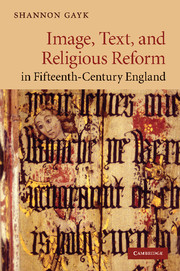Book contents
- Frontmatter
- Contents
- Acknowledgements
- List of abbreviations
- Introduction: reformations of the image
- 1 Lollard iconographies
- 2 Thomas Hoccleve's spectacles
- 3 John Lydgate's refigurations of the image
- 4 John Capgrave's material memorials
- 5 Reginald Pecock's libri laicorum
- Epilogue: words for images
- Notes
- Bibliography
- Index
- CAMBRIDGE STUDIES IN MEDIEVAL LITERATURE
- References
Bibliography
Published online by Cambridge University Press: 17 November 2010
- Frontmatter
- Contents
- Acknowledgements
- List of abbreviations
- Introduction: reformations of the image
- 1 Lollard iconographies
- 2 Thomas Hoccleve's spectacles
- 3 John Lydgate's refigurations of the image
- 4 John Capgrave's material memorials
- 5 Reginald Pecock's libri laicorum
- Epilogue: words for images
- Notes
- Bibliography
- Index
- CAMBRIDGE STUDIES IN MEDIEVAL LITERATURE
- References
- Type
- Chapter
- Information
- Image, Text, and Religious Reform in Fifteenth-Century England , pp. 229 - 249Publisher: Cambridge University PressPrint publication year: 2010



